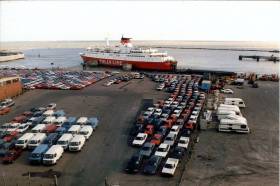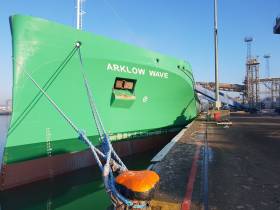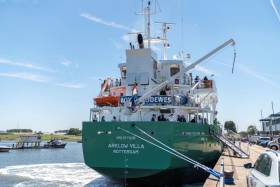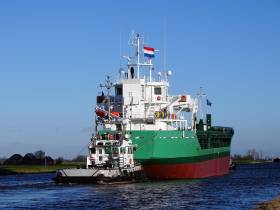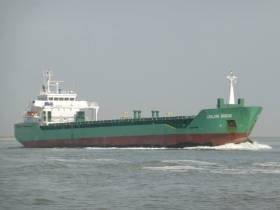Displaying items by tag: Arklow Shipping
Calls Mount for UK Transport Secretary Resignation Is Followed by Arklow Shipping Revelation
#ferries - The UK Transport Secretary reports Channel 4 News, has been facing mounting calls for his resignation after he cancelled a £14 million contract with ferry company Seaborne Freight.
The government pulled the rug on the contract yesterday after revealing that Arklow Shipping – a firm which was set to be a majority shareholder in Seaborne – had itself backed out.
But Channel 4 News (tonight) revealed that that company had never agreed any contract and blamed the UK government for pushing the deal through too fast.
For more on the proposed Ramsgate-Belgium service click report along with footage of Arklow Shipping's 8660dwat leadship 'B' class Arklow Bank and Bay when launched in the Netherlands, which Afloat reported of both back in 2014.
Sack UK Transport Secretary Over Brexit Ferry Fiasco, Demand MPs
#ferries - UK prime minister Theresa May faced cross-party calls to sack her transport secretary, Chris Grayling, last night, after the calamitous collapse of a no-deal Brexit ferry contract handed to a company with no ships.
As The Guardian reports, senior tories said the prime minister had turned “a blind eye” to Grayling’s decision to award the £13.8m contract to Seaborne Freight to run ferries between Ramsgate and Ostend, despite widespread derision and accusations that it had been awarded illegally.
The collapse of the contract comes amid growing unease in the international business community about Britain’s preparedness for a no-deal outcome, with less than 50 days until Brexit is due to take place.
Several MPs suggested Grayling should now consider his position after his department revealed the contract had been cancelled, and Bob Kerslake, the former head of the civil service, said the saga would “just confirm the view of many that this country is in a mess”.
Anna Soubry, a former Tory business minister, said Grayling “should be quietly considering his position”.
“Chris Grayling holds a critical position in government, trying to mitigate what would be a very serious crisis for the country if we leave the European Union without a deal,” she said. “He has no grip on the very serious nature of his job. The prime minister should also be considering whether there is not someone else who could do the job better.”
Another senior Tory MP said Grayling was a “walking disaster zone”, adding: “A no-deal Brexit would be a major national crisis and stories like this suggest we have not got the people in place who are capable of responding to it.”
Another said: “Grayling never has a grip on the detail, as the Seaborne mess shows. His Heathrow proposal will be just the same but way more costly. The PM just turns a blind eye, for some reason.”
Andy McDonald, the shadow transport secretary, said: “While Theresa May needs the few friends she has right now, we cannot have this incompetent transport secretary heaping humiliation after humiliation on our country. He has to go.”
Joining the attacks, Vince Cable, the Lib Dem leader, said: “I very rarely call on ministers to go, but failing Grayling has made too many crass mistakes. He has already lost the confidence of the civil service as they now require a ministerial directive for the government to spend money on ferries.”
Downing Street last night said the prime minister had full confidence in Grayling.
The Department for Transport said the deal was terminated after Irish company Arklow Shipping, which had backed Seaborne, stepped away from the deal. “It became clear Seaborne would not reach its contractual requirements,” a spokeswoman said. “We have therefore decided to terminate our agreement.”
For more on this ferry development, click here.
#ferries - RTE News reports that the UK's Department of Transport has cancelled a contract with a company to provide extra ferries in the event that the UK leaves the EU without a deal.
Seaborne Freight was awarded a £13.8m contract in December even though it had never run a ferry service, nor had any ships.
The British Government has cancelled the order after one of Seaborne's backers, the Irish (dry-cargo shipping) company, Arklow Shipping, withdrew from the deal.
The UK's Department of Transport said it was clear that Seaborne would not be able to meet its contractual requirements.
For more on the story click here in addition to related coverage on the Port of Ramsgate in Kent, from where the proposed route would serve Ostend in Belgium.
Newest Irish Flagged Leadship Waves In to Belfast Harbour
#shipping - The newest merchant ship under the Irish flag arrived to Belfast Harbour on Wednesday, writes Jehan Ashmore
Since delivery to owners Arklow Shipping Ltd in October 2018, Afloat has tracked the 16,500dwt Arklow Wave (see launch) initially operate in the Baltic Sea.
This latest call to Belfast involved the leadship of a new quartet of dry-cargo ships ordered by ASL from Ferus-Smit's GmbH yard in Leer, Germany.
A total 13,000mts of wheat was discharged from Arklow Wave according to COFCO a leading UK grain merchant. The cargo having been loaded in the UK's biggest grain port, ABP's Port of Ipswich on the Suffolk coast.
Discharging of the near 150m long cargoship followed after the W class newbuild took anchorage in Belfast Lough off Bangor, Co. Down.
Other recent ASL callers to the port included newbuild fleetmates, Arklow Villa also launched in 2018 whereas Arklow Clan was delivered the previous year.
Limerick Docks Restored Timber Built Ketch Trader 'Ilen' Recalls Celtic Spirit's Links With Arklow And Welsh Operators
#ShannonEstuary - The recent return to the Shannon Estuary, almost 100 years later of restored ketch trader Ilen, which Afloat highlighted, sees the sole surviving Irish built ocean-going timber sailing vessel back home in Limerick Docks, writes Jehan Ashmore
After a 20 year restoration project, the 56ft 'small tall ship' Ilen, returned last month to the estuary after an absence of 92 years as focused by Afloat's W.M. Nixon. The Illen, built to a Limerick design where such vessels traded on the estuary in Munster, had docked in the mid-west city port's Ted Russell Docks. Take note as Afloat previously reported, today's (Thursday) conivial Come-all-Ye party to celebrate the restoration at the Ilen Exhibition in the city's Hunt Museum (between 5.30 to 8.00pm). All are welcome.
On completion of Ilen in 1926, Conor O’Brien's ketch, built with an auxiliary engine, departed Limerick for Falklands Islands owners where for the majority of time served 60 years in inter-island cargo trade deep in the South Altantic Ocean. Last month, however Ilen would finally sail up the Shannon Estuary again having made a delivery passage from Baltimore (where built), retracing a preparatory journey to Foynes made by O'Brien in advance of the ocean delivery to the Falklands Islands Company.
The small cargoship having become abandoned, eventually returned as deck cargo to Ireland when loaded ashore in Dublin Port in 1997. In the following year work began to restore the unique Irish built sail ocean going cargoship.
Close to Baltimore is where Ilen, mid-way through its restoration, in 2008 was given a new lease life thanks to the ketch receiving the skilled craftmanship at Liam Hegarty’s boatyard in Oldcourt, upriver on the River Ilen from Skibberean. Much of the restorations detailed work of mast and sail work, though took place at the Ilen Boat-Building School in Limerick.
Also in 2008, a personnal visit took place to the city's Ted Russel Docks to examine the commercial shipping scene, albeit then no sail traders of the past but motorised ships such as Celtic Spirit. The general cargo short-sea trader (pictured above) in the port's single dock basin is seen in October just over a decade ago with Inland Fisheries Ireland patrol cutter Costantoir Bradan.
As W.M. Nixon also alluded in recent coverage of Ilen (scroll down to photo) which sparked memories as the scene included a blue hulled cargoship (likewise of Celtic Spirit). The shipping scene shows the stark contrast in the Dock between the restored ketch complex foredeck and completely differs to those experienced by sailors on the modern ships nearby.
The unidentified blue hulled ship is similar in size to Celtic Spirit, which then had opened up a new service in trading round timber (logs). Trees felled from commercial forests in Co. Tipperary were the source and if recalled correctly, also involved plantations from some of the neighbouring counties. A dockside grabber crane would seize several logs at a time before swung speedily into the hold of Celtic Spirit whose cargo was bound for a European port.
Celtic Spirit no longer forms part of the current 9 strong fleet of Welsh based operator, Charles M.Willie & Co.(Shipping) Ltd located in Cardiff. A successor of the same name serves alongside a fleetmate, Celtic Freedom acquired last year from Arklow Shipping Nederland B.V. as their Arklow Rally. Also sold but in 2016 was Arklow Shipping Ltd's (ASL) Irish flagged Arklow Rose which was renamed Celtic Venture.
At the time of that report another of ASL oldest R-class short sea traders, Arklow Raider had called to Limerick Docks. The dock basin is one of six terminals operated by Shannon Foynes Port Company (SFPC) which recorded a third consecutive year of record profits as 2017’s return in turnover was close to €14 million.
The presence of Ilen in Limerick's Ted Russell Dock (completed in 1853) brings the past and the present to co-exist in terms of demonstrating traditional Irish maritime heritage and modern day shipping and aptly Arkow Shipping, Ireland's largest indigenous shipowner-operator.
As previously alluded in the year Ilen was built (1926), Ted RusselI Docks that same year reported around 100 importers and exporters using the port. At that time, the dock's principle client were the flour millers, John Bannatyne & Sons.
The activities of Bannatyne contributed to approximately half of the revenue to Limerick Harbour Commissioners (from 1994, SFPC). Only last year, SFPC's Limerick Docklands Framework Strategy announced plans to reinstate historical buildings over time such as the large Ballantyne Mills building that occupies the main quay lining Ted Russell Docks.
Exports from Limerick Docks more than tripled imports in 2016, which shows how the dock basin asset has contributed to business in the city and the wider mid-west region. Another recent caller last month to the Dock was again from ASL whose Arklow Cadet (also dating to 2016) which docked in the inland port located on Ireland's largest estuary.
#Ports&Shipping - Another progressive chapter for Arklow Shipping was notably marked on Monday as the final of 10 newbuild short-sea traders was christened at a ceremony held in The Netherlands, writes Jehan Ashmore.
Arklow Villa was christened in Delfzijl, where glorious weather conditions added to the celebrations as the 86m long hulled vessel built by Royal Bodewes was named. The occasion saw the newbuild use the 'V' naming theme with the cargoship berthed along the quayside close to the Ems Estuary, shared with neighbouring Germany.
The ceremony took place five days after the start of sea-trails began in the North Sea. Prior to these trials, the newbuild like all 9 sisters since 2015, beginning with leadship Arklow Vale were launched at the inland yard in Hoogezand and then towed on the canal network to Delfzijl.
Arklow Villa joins ASL's Dutch division, Arklow Shipping Nederland B.V. and likewise to all the Bodewes Eco-Traders, they fly the Dutch flag and have Rotterdam as a port of registry. The introduction of the newbuild brings to more than 50 dry-cargo and bulk-carriers in the combined Dutch-Irish flagged fleet.
Afloat has carried out further research to astertain that the maiden commercial voyage by Arklow Villa also took place on the day of the naming ceremony. This involved the 2,999 gross tonnage newbuild make a departure from the Dutch north-east port to Porsgrunn, Norway.
It is from the southern Norwegian port that the Royal Bodewes 5,170dwt Eco-Trader an in-house design from the Dutch yard, is next to sail to Belfast Harbour. Afloat also notes that the inaugural call to the Northern Ireland port is estimated to take place on Saturday.
As for cargo operartions, the hold is fitted with portable bulkheads that can be placed in 8 positions for cargo separation and storage. The hatch deck is equipped with a Coops & Nieborg pontoon system.
A main engine comprises of a MaK 6M25 1740 kW where through a controllable pitch propeller delivers a speed of around 12.5 knots.
For in port handing and when within confined spaces the straight-stemmed bow designed to minimise wave impact for fuel efficiency, is equipped with an electric bowthruster of 300 kW.
Third Former Flinter Sister Acquired by Arklow Shipping
#Ports&Shipping - Arklow Dale is the first cargoship to bear the name for the Co. Wicklow based shipowner which acquired the secondhand tonnage that forms as the third D class sister, writes Jehan Ashmore.
Afloat had been trawling through the mixed Irish-Dutch flagged fleet list of Arklow Shipping yesterday. Coincidently, on the same day is when that the newly acquired cargoship was included in the fleet list of more than 50 ships.
The 11,048dwt cargoship is the former Flinter Arctic that served a career with the Dutch operator, Flinter Group B.V. which became bankrupt in 2016. Trading now as Arklow Dale, the double-hold cargoship is equipped with a deck-mounted gantry crane fitted with two derricks. The 132m cargoship has an Ice Class Finnish 1A notation and is currently underway in the Baltic Sea from Gdynia, Poland and bound for Lulea in Sweden.
Arklow Dale joins the other D class pair of former Flinter sisters that were previously disposed through auction to ASL and sail as Arklow Dawn and Arklow Day. The sisters were all built by German shipbuilder, Ferus Smit whose Dutch yard in Westerbroek launched Flinter Arctic in 2010. As for the remaining sisters they were completed in the following year. The yard in recent years has seen the construction of C class cargoships for ASL.
The newly acquired fleetmember's main engine is a 3 MAK 8M32 4000kW with gearbox. A controllable pitch propeller delivers about 14 knots. All of the D class are Irish flagged and registered in the owners homeport whereas Dutch based divison Arklow Shipping Nederland B.V. have a smaller fleet registered in Rotterdam.
#Ports&Shipping - Arklow Viking began sea trials yesterday, the brand new short-sea trader having been towed from an inland Dutch yard to the North Sea, writes Jehan Ashmore.
The 2,999grt Arklow Viking marks the 9th of ten multipurpose cargoships that will serve Arklow Shipping Nederland B.V. The class constructed by Royal Bodewes shipyard are built to an in-house design, the Eco-Trader 5150 series.
It was on Monday, that a pair of tugs towed the 89m Arklow Viking from the yard in Hoogezand near Groningen on the canal network to Delfzijl on the Ems Estuary. The newbuild undertook sea trials and when not underway the vessel in based out of Emshaven.
As for final sister of this series, the newbuild is to be named Arklow Villa and as revealed on the stern, the port of registry is Rotterdam. This is not surprising as ASN are based in the giant deep-water port.
Around 50 cargoships operate under the Irish and Dutch flagged fleet, they mostly comprise of short-sea traders in addition to deep-sea bulkers.
#Ports&Shipping - Arklow Venus, the newest ship of the fleet that was launched in October is currently undergoing sea trials on an estuary along the Dutch-German border, writes Jehan Ashmore.
The 89m Arklow Venus is part of the continues upgrading of Arklow Shipping ships. The new addition is the eight sister so far completed out of 10 placed on order of the 'V' class or Eco-Trader 5150 series designed in-house by the yard of Royal Bodewes. The figure refers to the cargoship's deadweight while gross tonnage is measured at 2,999.
Previously, the new short-sea trader had departed Bodewes inland shipyard at Hoogezand on Winschoterdiep Canal that links to the Eemskanaal Canal leading to Delfzijl on the Ems Estuary. As of this morning Arklow Venus made first contact with the salt waters of the Ems Estuary that has a border between The Netherlands and Germany.
The short sea trader that has a hold that can be divided for two bulk cargoes, headed out of the estuary towards the North Sea but remained within the the island archipelago of the Frisian Islands also known as the Wadden Islands.
Upon completion of sea trails the ship will join ASL's Dutch divison Arklow Shipping Nederland B.V. located in Rotterdam.
Shipping Snippets: Ardmore Tanker Calls to Bantry, Arklow Disposes Cargoship & Mainport Chase Vessel Departs Cork Dockyard
#ShippingSnippets - A 183m tanker from Ardmore Shipping Corporation based in Bermuda which also has a principle operating office located in Cork, made a call to Bantry Bay recently, writes Jehan Ashmore.
Ardmore Seaventure which at 49,999 dwt is on of the largest of the 27 strong fleet had anchored at the single point mooring (SPM) system at the Whiddy Island oil terminal. The ship had sailed from Ventspils, Latvia and has since headed to west Scotland. Until yesterday, the tanker had taken anchorage in Brodrick Bay, Isle of Arran (see 'Superyacht' posting).
Bantry Bay Terminals is operated by Zenith Energy, where the facility is also capable of handling VLCC’s and 30-meter draft vessels for the discharging of petroleum cargoes and other products.
Another short-sea trader from Arklow Shipping Nederland B.V., Arklow Bridge is no longer part of the Dutch division fleet. The 4,723gt vessel only built in 2011, is one of a pair of original 'B' class ships. The other sister Arklow Brook remains in service. They differ to a succession of ships from a varient of the 'B' series also built by Bodewes in the Netherlands.
Afloat has tracked down the 116m cargoship which has been renamed Aasvik, when berthed in Szczecin,Poland. Also a change of flag to Gibraltar has taken place.
An earlier 'Brook' had served ASL, having been custom built at Appledore Shipbuilders in 1990 followed by sister 'Bridge' the next year. The yard in Bidna, north Devon is now Babcock Marine & Technology's facility that is currently constructing the Naval Service's fourth OPV90 sister to be named L.E. George Bernard Shaw.
Cork based Mainport Group's seismic chase vessel, Mainport Kells has been at the Cork Dockyard facility. The 350grt vessel of only 37m built almost a decade ago at the Shin Yang yard Malaysia in 2008, had yesterday carried out sea trials beyond the harbour off Roches Point Lighthouse.
Corkonians would of seen Mainport Kells berthed previously at Cork city quays. A fleetmate the seismic survey vessel Mineport Pine remains there along North Custom Quay.






























